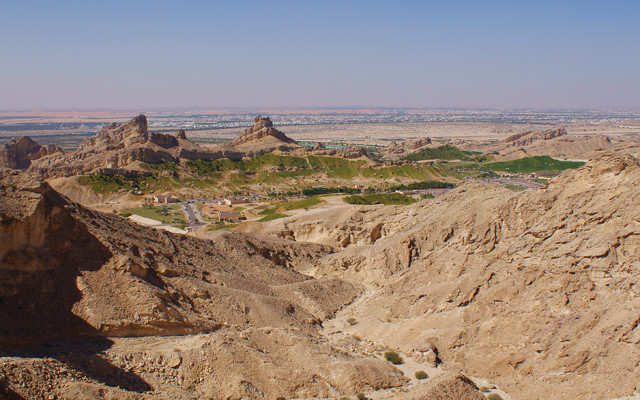
by Mary Caperton Morton Monday, July 13, 2015

In a quarry near the city of Al Ain, in the eastern part of the emirate of Abu Dhabi, scientists found evidence of recurring wet climates in the Arabian Peninsula dating back roughly 160,000 years. Credit: ©Nepenthes, CC BY-SA 3.0.
The vast sea of sand that is much of the Arabian Peninsula presents a formidable barrier to travel, even with today’s modern conveniences. How and when our ancestors crossed this dry expanse after leaving Africa — on their way to populating the rest of the world — has long been a mystery. Now, a new paleoclimate study paints a wetter picture of Arabia during the time of human expansion, and the findings may change scientists’ thinking about the route and timing of early human migrations out of Africa.
“The landscape of Arabia is seemingly barren, but underneath its surface lies a rich history of a very different climatic regime, with ancient lakes and flowing rivers,” says Ash Parton, a paleoclimatologist at the University of Oxford and lead author of the new study in Geology. Such freshwater bodies would’ve vastly improved conditions for humans passing through the Arabian interior.
Only a handful of paleoclimate studies have focused on the Arabian Peninsula in recent years due to political and logistical barriers, Parton says, and those studies have only revealed part of Arabia’s story. Previous Arabian paleoclimate records also “haven’t been very sensitive” to past climate changes, he says. Isotopic and geochemical records from speleothems — layered mineral deposits found in limestone caves — “have been the basis of our understanding of the Arabian paleoclimate for the past few decades.” But speleothems generally require more than 350 milliliters of precipitation per year to grow, meaning they don’t record dry periods very well.
To get a more detailed look at the peninsula’s climate, Parton and colleagues turned to an alluvial fan sequence preserved in a quarry in the southeast portion of the peninsula. Located near Al Sibetah in the United Arab Emirates, the 42-meter-deep sequence reaches back 160,000 years and includes evidence — such as stream-deposited gravels juxtaposed with windblown sands — that the region’s climate varied dramatically. “This sequence quite clearly shows multiple phases of the landscape, from quite arid to [times when there were] flowing rivers,” Parton says.
Using optically stimulated luminescence to date the layers in the alluvial sequence, the team found a pattern of high rainfall about every 23,000 years, aligning with periodic changes in Earth’s orbit around the Sun that are to known from marine paleoclimate records to intensify monsoon weather. Previously, Arabia was thought to have seen increased rainfall only on 100,000-year interglacial cycles.
“This greening of Arabia every 23,000 years means that there were more windows for humans to disperse from Africa into Arabia than originally thought,” Parton says, suggesting that multiple dispersions could have occurred, perhaps beginning as early as 130,000 years ago. The new alluvial fan records also help make sense of some archaeological sites — where caches of stone tools have been found — that correspond to “odd dates during glacial cycles, when Arabia was thought to be inhospitable,” he says. And they tell an alternative story of freshwater corridors extending into the interior of Arabia, possibly facilitating interior routes of human migration out of Africa.
Traditionally, anthropologists have thought that ancient humans first crossed Arabia to southern Asia between 60,000 and 50,000 years ago in a rapid expansion, following the Arabian coastline, where they could exploit plentiful marine food sources and avoid the arid interior, says Paul Mellars, an archaeologist at the University of Cambridge who was not involved in the new study.
“I remain convinced that the main route of dispersal was along the coast, mainly because … there’s always something to eat,” Mellars says. “However, that does not rule out the possibility put forward by [Parton and colleagues] that some groups moved inland during periods of wetness.”
The next step is to seek out more alluvial fan sequences and work on improving the paleoclimate record for the whole of the Arabian Peninsula, Mellars says. “This is probably the best paleoclimate record we have for Arabia, but this [sequence] represents just one corner of a vast region.”
Mellars says he would also like to see more work identifying even older archaeological sites and hopes that skeletal remains left behind by the first migrants out of Africa will eventually be found. “We have strong archaeological evidence that there were [hominids] living in Arabia as early as 130, 000 years ago, but all we know about them is through their tools. We don’t know if they were modern humans or another sub-species.”
Parton agrees there is much to be learned about the region’s history. “Arabia has been terra incognito over the past few decades,” he says. “I think we’ll start seeing some really interesting discoveries coming out of this corner of the world in the next few years.”
© 2008-2021. All rights reserved. Any copying, redistribution or retransmission of any of the contents of this service without the expressed written permission of the American Geosciences Institute is expressly prohibited. Click here for all copyright requests.